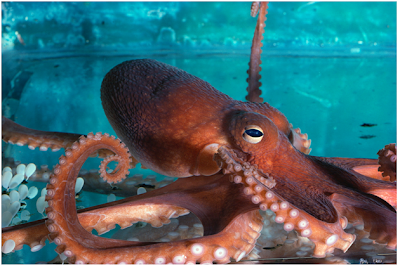Octopuses are highly intelligent, probably more than any other order of invertebrates. When under attack, some octopuses can perform arm autotomy in a manner similar to the way skinks and lizards detach their tails. The trailing arm serves as a distraction to would-be predators.
It's a common mistake to refer to the arms of an octopus' tentacle-like. The tentacles are longer than the arms. Tentacles usually have suckers only at the tips.
Three plural forms of the word octopus - octopi, optopuses, and octopodes.
The Giant Pacific Octopus, Enteroctopus dofleini, is often cited as the largest octopus species.
The neurological autonomy of the arms means that the octopus has great difficulty learning about the detailed effects of their movements. The brain may issue a high level command to the arms, but the nerve cords in the arms execute the details. There is no neurological path for the brain to receive feedback about just how its command was executed by the arms; the only way it knows just what motions were made is by observing the arms visually. There are about 300 species of octopuses (Octopoda) alive today.
These species are are divided into two groups, the Cirrina and the Incirrina.
The Cirrina - finned, deep-sea octopuses
The Incirrina -the benthic octopuses and argonauts


Leave A Comment EmoticonEmoticon